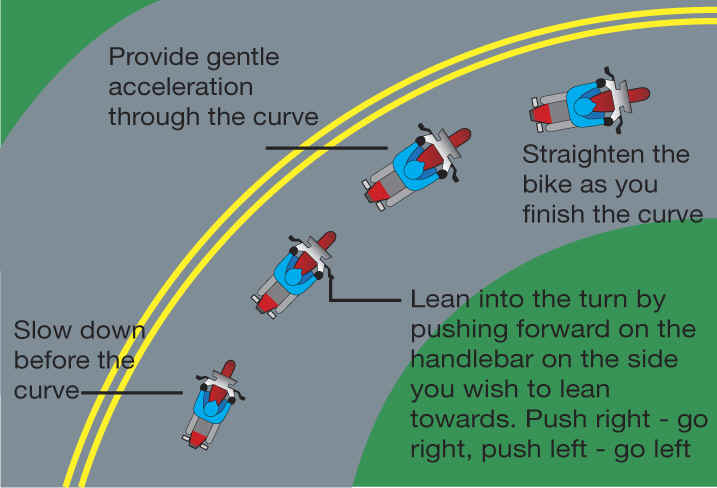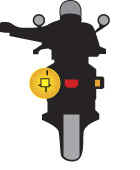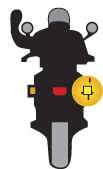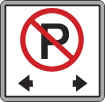Do not confuse other drivers by signaling too early or too late. Remember to cancel the signal light if it does not turn off automatically. In some situations, use a hand signal as well as a turn signal light to make yourself more visible to drivers.
| ||||
|
|
| |||
| Left turn | Right turn | |||
Low-speed steering for a turn When riding at slow speeds generally less than 20 km/h, a motorcycle can be steered by turning the front wheel in the direction you want to go. This requires good balance and coordination between the clutch, throttle and rear brake. Practice doing this in a safe, traffic-free area. Use a light but firm grip on the handlebars for all turns. The application of a turn at an intersection is the same for a motorcycle as other vehicles. Since motorcyclists are more vulnerable at an intersection, extra caution and a controlled speed is required when entering, and riding through a turn. | ||||
Counter-steering (push-steering) for a curve
When riding at speeds greater than 20 km/h in a curve, you must follow the lean of the motorcycle and will need to master the skill of counter-steering (push-steering). Counter-steering means, steering one way to send the bike in the opposite direction. In a curve at higher speeds, a motorcycle is pushed outward by centrifugal force. To counter this outward push, the motorcycle must lean inward. The greater the speed, the more the motorcycle must lean. To create this inward lean, push on the left handlebar to turn left and push on the right handlebar to turn right. Increasing the amount of push will increase the lean to allow a sharper and quicker change in direction. When the steering input is completed, simply release the pressure on the handlebar. If necessary, apply pressure on the opposite handlebar to assist in straightening the motorcycle.
When traveling around a curve:
- Reduce speed when approaching a curve. Many motorcyclists, especially inexperienced ones, misjudge their speeds and attempt to corner too quickly. Slow down even more when road or weather conditions are poor.
- If braking or downshifting, do it before the curve.
- Rather than looking at one spot or immediately in front of your bike, turn your head and keep your eyes looking through the curve to where you want to go.
- Lean in the direction of the curve by counter-steering (push-steering).
- Avoid slowing down suddenly while in the curve. Sudden changes in speed while in a curve could cause the motorcycle to lose traction.
- Gently accelerate when leaving the curve.
 | |||
|
| |||
Park where it is safe and legal. Signs, curb markings and common sense will tell a rider where parking is permitted. Park at an angle, other than perpendicular to the curb or edge of the roadway with your rear wheel no more than 50 centimetres from the curb. Note: Motorcycles are permitted to park at an angle where other vehicles are required to park parallel to the curb. Your motorcycle may have a centre stand, a side stand or both. These are usually operated from the driver?s left side. When leaving your bike parked, make sure the front wheel is turned fully to the left, locked and the ignition key is removed. | |||
| Hill parking | |
When parking on a hill, it is best to park facing uphill to avoid having the bike roll forward off the stand. If a curb is present, have the rear wheel make contact with the curb to prevent the bike from rolling back if using a side stand. Tq to Government of Alberta --> http://transportation.alberta.ca | |



No comments:
Post a Comment